Trends
Global dermatology devices market to hit USD 50.43B by 2033

According to Vision Research Reports, the global dermatology devices market size was estimated at USD 15.31 billion in 2023 and it is projected to hit around USD 50.43 billion by 2033, growing at a CAGR of 12.66% from 2024 to 2033. The dermatology devices market is driven by a confluence of factors including technological advancements, rising prevalence of skin disorders, and increasing awareness regarding aesthetic procedures.
What is the dermatology devices?
Dermatology devices encompass a range of medical instruments and equipment utilized in the field of dermatology, specializing in the diagnosis and treatment of skin disorders. These devices serve diverse functions, from aiding in the examination and analysis of skin lesions through dermatoscopes to conducting therapeutic procedures such as laser and light therapy for conditions like hair removal, skin rejuvenation, and lesion treatment. Cryotherapy devices administer targeted cold temperatures to eliminate abnormal skin cells, while electrosurgery instruments utilize high-frequency electrical currents for cutting, coagulating, and removing tissue.
Additionally, microdermabrasion machines help in skin exfoliation, ultrasound devices aid in diagnostics and guided procedures, and skin analyzers provide insights into skin health parameters. Dermatological surgical instruments are essential for various dermatologic surgeries, including excisions and biopsies. These devices collectively facilitate accurate diagnosis, personalized treatment, and enhanced patient care in dermatology practice.
Product insights
The treatment devices segment dominated the market with a share of approximately 80% in 2023 and is projected to maintain the highest compound annual growth rate (CAGR) throughout the forecast period. This is primarily due to the broad spectrum of applications offered by dermatological treatment devices. Furthermore, the introduction of novel technologies within the laser device category has significantly contributed to the robust growth observed in this segment. Conversely, the relatively lower market share of diagnostic devices can be attributed to limited awareness regarding emerging diagnostic instruments. Nevertheless, the escalating prevalence of skin cancer is expected to bolster the growth trajectory of this segment in the forthcoming years.
Within the treatment devices category, laser products commanded the largest market share in 2023 and are poised to exhibit the most substantial growth over the forecast period, driven by their widespread adoption. Conversely, dermatoscopes emerged as the dominant segment within the diagnostic devices category in 2023, owing to the availability of advanced technological features.
The dermatology diagnostic devices market is forecasted to witness notable expansion over the forecast period, fueled by the escalating prevalence of dermatological conditions on a global scale. The surge in skin disorders, coupled with heightened awareness regarding early detection and treatment, has propelled the demand for advanced diagnostic devices within the dermatology devices market.
Application insights
In 2023, the hair removal application segment emerged as the market leader, holding the largest share. Within the treatment application segment, hair removal is one of several categories, including skin rejuvenation, acne treatment, psoriasis management, tattoo removal, wrinkle reduction, skin resurfacing, body contouring, fat removal, cellulite reduction, vascular and pigmented lesion removal, and others.
According to data from the International Society of Aesthetic Plastic Surgery, plastic surgeons worldwide reported a substantial increase in procedures performed in 2022. The statistics revealed an 11.2% rise in overall procedures, with over 14.9 million surgical and 18.8 million non-surgical procedures conducted globally. This trend underscores the increasing demand for aesthetic treatments, which will directly influence the adoption of advanced and efficient dermatology devices.
End-Use insights
In 2023, the hospital segment dominated the market, holding the largest share, primarily due to the presence of advanced dermatology equipment within hospital settings. Additionally, the wide array of treatment options available in these facilities has contributed to an increased number of visits for skin disease diagnosis and treatment.
The demand for specialized skin care treatments has prompted patients to seek services from specialty dermatology clinics, resulting in significant growth in this segment. Moreover, the global rise in the prevalence of skin cancer and melanoma, coupled with the growing number of clinics offering skin care services, has further bolstered patient visits to dermatology clinics for treatment and care.
Clinics serve as both cosmetic and medical facilities specializing in the diagnosis and treatment of various skin conditions. They provide a range of services, including both surgical and nonsurgical procedures, administered by certified plastic surgeons. According to TripleTree, as of 2020, there were 9,000 dermatology practices and 14,000 dermatologists in the United States. Among these practices, 34% operated as solo practices, while 48% included three or more physicians.
Regional insights
In 2023, North America held the largest revenue share in the market, accounting for 44%. This dominance is attributed to several factors, including the rising prevalence of skin cancer and other skin conditions such as acne, eczema, and rosacea. Additionally, the increasing adoption of cosmetic procedures has contributed to market growth in this region.
The U.S. dermatology device market is projected to sustain its growth momentum in the upcoming years. This growth will be driven by factors such as the growing demand for non-invasive and minimally invasive treatments, continuous advancements in technology, the introduction of new devices, and the escalating prevalence of skin care diseases. According to the Centers for Disease Control and Prevention (CDC), Acne vulgaris affects 80% of the U.S. population at some point in their lives, with 20% experiencing severe acne, which can lead to permanent physical and mental scarring. Vision Research Reports












